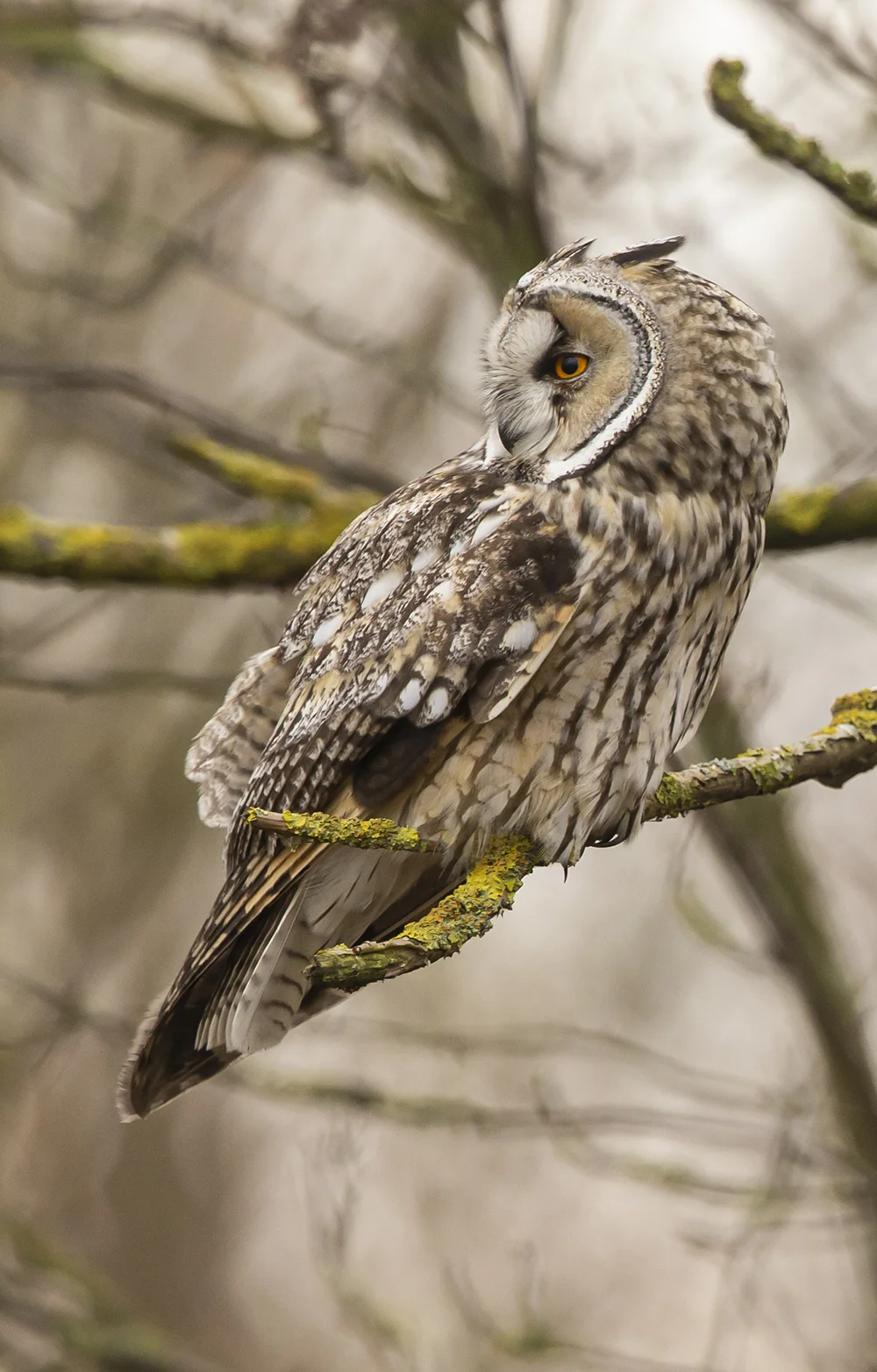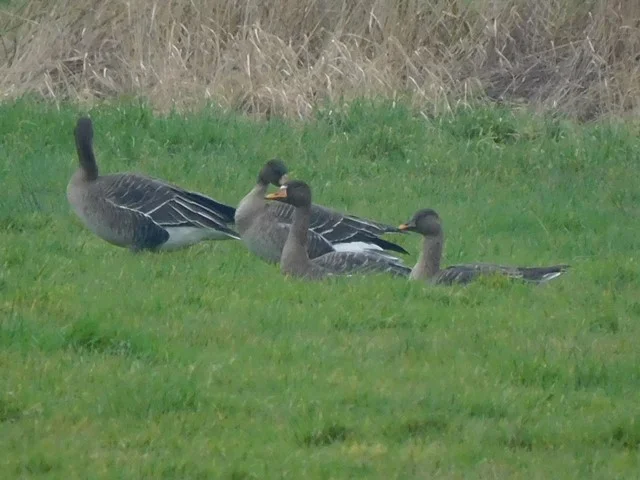There was plenty to love in an eventful week for birding across Britain and Ireland, highlighted by news on Valentine's Day of a mega East Asian bunting in an inland county. With plenty of new rarities and scarcities to boot, it was a dynamic seven days that offered plenty of excitement.
The landlocked county of Shropshire was the unlikely host of the rarest bird of the year so far, with a ringing session at an undisclosed farmland site producing a first-winter male Black-faced Bunting, alongside the expected Yellowhammers and Reed Buntings. The ninth British record, it is now the third to have been found thanks to the aid of mistnets, following Britain's first at Pennington Flash, Greater Manchester, in March-April 1994 and one at Nanjizal Valley, Cornwall, last November. It is also one of two found in western Europe this week, with another on the outskirts of Valencia, Spain, from 12th.

Black-faced Bunting, undisclosed site, Shropshire (West Midlands Ringing Group).
In Shetland, meanwhile, a periodic survey visit to Yell Sound delivered the goods on 13th, with a Brünnich's Guillemot at close range off the survey vessel. Described as a "mythical Arctic creature" by one of the finders, this individual bucked the trend and gave itself up, being well documented in a range of excellent photographs. It also serves as a reminder of the potential riches that a northerly midwinter blow in can provide across Britain. Of the 15 previous Shetland records, nine have occurred in during the winter months – and four of those in February. Subsequent surveys the following day provided views of the long-staying King Eider off Fetlar.

Brünnich's Guillemot, Yell Sound, Shetland (Roger Riddington).

King Eider (back) with Common Eider, Fetlar, Shetland (Roger Riddington).
Later on 13th, another Arctic wanderer hit the headlines at the opposite end of Britain – a first-winter Ross's Gull in Dorset, no less. Typically thought of as a strictly coastal visitor, equally surprising was its choice of inland locality – present 10 km north of Weymouth at Dorchester Water Meadows. The last record for Dorset – an adult at Weymouth in February-March 2018 – resided in the area for 11 days. Unfortunately, this latest bird didn't prove as accommodating, with no sign the next day.

Ross's Gull, Dorchester, Dorset (John Wall).
One larid proving much more obliging was the Cornish first-winter American Herring Gull, which resurfaced at Hayle Estuary alongside the regular Ring-billed Gull from 15th and proved reliable thereafter. Four more Ring-billed Gulls were in Ireland, split between Co Louth, Co Fermanagh, Co Mayo and Co Kerry. Intriguing news from Cornwall concerned a possible first-winter Glaucous-winged Gull east past Pendeen on 18th, although proving a bird in this plumage on flight views only feels like a tall order given its extreme rarity.

American Herring Gull, Hayle Estuary, Cornwall (Graham Jepson).
Both Glaucous and Iceland Gulls were again thin on the ground, while Cambridgeshire's adult Kumlien's Gull extended its stay at Smithy Fen. The Forster's Tern resurfaced at Traught, Co Galway, over the weekend, while a pale-morph adult Long-tailed Skua looked forlorn on St Mary's, Scilly, on 18th. Otherwise, two White-billed Divers were in Shetland and the Co Leitrim Double-crested Cormorant held on.

Iceland Gull, Erith, London (Richard Bonser).
Typically a summer or autumn visitor to these shores, a first-winter White-rumped Sandpiper with Dunlin at Slimbridge WWT, Gloucestershire, from 14th provided quite a surprise and is the first February bird on record. A Grey Phalarope at Port Talbot Docks, Glamorgan, was new, while lingering rarities comprised the Co Waterford Greater Yellowlegs and Norfolk Long-billed Dowitcher.

White-rumped Sandpiper, Slimbridge WWT, Gloucestershire (Ian Curran).

Long-billed Dowitcher (left) and Black-tailed Godwit, Cley Marshes NWT, Norfolk (Neil Rendall).
A possible Nutcracker reported at Styal, Cheshire, on 11th would undoubtedly prove one of the birds of the winter if it was firmed up. Not many species enjoy quite as many erroneous claims at Nutcracker, however, so it is a claim worth treating with a more than healthy pinch of salt. An untwitchable bird in Caithness in November 2021 aside, we have to look back as far as the 1990s for the last run of British records – two in 1991 followed by singles in 1996 and 1998.
In North Yorkshire, meanwhile, a male Black-throated Thrush at Wykeham Forest on 19th was a first for the Scarborough recording area. Elsewhere, a couple of Ring Ouzels were in south-west England and Waxwing numbers continued to dwindle, although three again in Co Down were well-received.

Black-throated Thrush, Wykeham Forest, North Yorkshire (Jason Higgins).

Waxwing, Bradford, West Yorkshire (Tony Davison).
All three Hume's Leaf Warblers chalked up another week and, on the outskirts of Bristol, a new Yellow-browed Warbler was at Westbury-on-Trym. The Pallas's Warbler at Newfield, Durham, stepped it up a gear by engaging in bouts of song – a rare opportunity to hear this delightful Siberian sprite in Britain. A probable Siberian Lesser Whitethroat was reported again at Exmouth, Devon, although a Lesser Whitethroat at Sheringham, Norfolk, from 13-15th was perhaps a better match for a nominate curruca.

Pallas's Warbler, Newfield, Durham (Joe Fryer).
December's Eastern Yellow Wagtail candidate reappeared at Carlton Marshes, Suffolk, at the start of the week. More accommodating this time around, its identity was firmed up the following day and it would remain on site until the week's end.

Eastern Yellow Wagtail, Carlton Marshes SWT, Suffolk (David Borderick).
In Cornwall, the Isabelline Wheatear remained at Holywell throughout and the two Little Buntings were again at Cot Valley. Richard's Pipits were again in Dorset and Scilly, with Shore Larks comprising at least 13 in Norfolk and one in Hampshire.

Isabelline Wheatear, Holywell, Cornwall (Richard Bonser).

Shore Lark, Hurst Beach/Castle, Hampshire (Lee Fuller).
This week's single Great Grey Shrike is a pitiful February total – the bird at Shatterford, Hampshire. Mainland Shetland boasted a Hornemann's Arctic Redpoll, while the Co Mayo bird was again at Tarmon. A Eurasian Penduline Tit was photographed at Ham Wall RSPB, Somerset, on 19th. Given this week's mild weather and south-westerly winds, early House Martins over Kessingland, Suffolk, and Ballycotton, Co Cork, were not entirely unexpected.
The extended presence of the Long-eared Owl at Glandford, Norfolk, continued to raise a decent chunk of money for charity; other publicised roosts saw birds reported from Elmley NNR, Kent, and Deeping Lakes, Lincolnshire. Elsewhere in Norfolk, the young female Pallid Harrier held out at Warham Greens, with the Rough-legged Buzzard at Birsay Moors RSPB, Mainland Orkney, noted on two occasions.

Long-eared Owl, Deeping Lakes LWT, Lincolnshire (Will Bowell).
Both White-winged Scoter remained at their respective sites, as did the Black Scoter at Bamburgh, Northumberland. A couple of Surf Scoter provided uncharacteristically good views off Llanddulas, Conwy, for much of the week. Another remained off Anglesey, with four more in Scotland (one off Lothian and three off Argyll). Shetland aside, King Eider were again in Lothian and Cleveland. In the Outer Hebrides, the Harlequin Duck performed admirably at Traigh Eais, Barra.

Surf Scoter (centre and far right) with Velvet Scoter, Llanddulas, Conwy (Tony Pope).
Three Ferruginous Duck were still at Filby Broad, Norfolk, and all three Lesser Scaup – in Somerset, London and the Outer Hebrides – continued. In Co Mayo, the Hooded Merganser at Rosduane racked up another week, with 35 Ring-necked Duck noted across 28 locations. Three females at Cloonacleigha Lough, Co Sligo, constituted the largest gathering.

Ring-necked Duck, Birnie & Gaddon Lochs NR, Fife (Kenneth O'Keefe).

Lesser Scaup (centre), Ham Wall RSPB, Somerset & Bristol (Christopher Ellis).
Three American Wigeon were split between Northumberland, North Yorkshire and Somerset, although the drake Baikal Teal wasn't noted at Foryd Bay, Gwynedd, after Monday. More than half of the week's Green-winged Teal resided in Scotland; new birds were at Two Tree Island, Essex, Port Carlisle, Cumbria, Cors Ddyga RSPB, Anglesey, Loch of Heogland, Unst, and Lough Beg, Co Londonderry.

American Wigeon (right), Shapwick Heath NNR, Somerset & Bristol (Steve Hopper).
A new Todd's Canada Goose accompanied Greenland White-fronted Geese on Islay at Ballinaby. Both of the island's headling geese remained – the Red-breasted Goose at Loch Gruinart RSPB and Richardson's Cackling Goose at Bridgend. Cumbria's Red-breasted Goose relocated to Brownrigg from 15th, while another Richardson's Cackling Goose lingered on The Mullet, Co Mayo.

Todd's Canada Goose, Ballinaby, Islay, Argyll (Steve Percival).
A Lesser White-fronted Goose with Pink-footed Geese on the Dee Marshes along the Clwyd-Cheshire border on 18-19th likely relates to the known wandering escape. The next estuary over, a Snow Goose dropped in with Pink-feet at Ince Marshes, Cheshire, on 19th, with others still in Orkney and Co Mayo. Norfolk's dozen Taiga Bean Geese extended their stay at Ludham Bridge. Grey-bellied Brant were again in Cos Down and Dublin, with Black Brant remaining in Hampshire and Essex.

Taiga Bean Geese, Ludham Bridge, Norfolk (Simon Jeffs).
Glossy Ibis were at seven locations, wayward Common Cranes overflew Heartwood Forest, Hertfordshire, and Tattenhoe, Buckinghamshire, and the White Stork lingered at Worth Marsh, Kent. Amusingly, two Western Cattle Egrets in the Nottingham-Derby area bucked the trend by wandering suburban parks and housing estate verges in search of sustenance.

Western Cattle Egret, Chilwell, Nottinghamshire (Miles Cluff).
Western Palearctic
The very last report of the week brought with it very exciting news from Cape Verde, where at least one (and probably two) Black-capped Petrels were recorded off the coast of Ribeira Grande, Santo Antão, on 17th and 19th. Sighted among an evening gathering of Fea's Petrels, which were waiting for darkness to head inland to their breeding colonies, it is tempting to speculate that the Black-capped might have been doing the same. Prior to this year, there are five records for Cape Verde, all recorded between the months of January and April. Even more notable still, two of these were caught inland on Santa Antão. Given this pattern of records for what is thought to be a Caribbean breeding endemic, might a small colony exist undetected in this Western Palearctic extremity?
In the far east of the region, Kuwait picked up the honours of the week's rarest find: an Ashy Drongo at Salmiya. Just the sixth for the Western Palearctic, Kuwait has produced five of those, most recently one in December 2020. Meanwhile, the Pied Bush Chat and Three-banded Plover both lingered in Israel.
Mainland Europe's second Grey-tailed Tattler at Étang de Thau, France, continued to attract a steady stream of admirers. A Lesser Flamingo in the Camargue at Pont de Gau added additional interest a short distance away. Otherwise, French birders continued to enjoy a Least Sandpiper at La Guittière, Forster's Tern at Plounéour-Trez, American Herring Gull at Gueltas, and Long-legged Buzzard at Thibie. A young Sociable Lapwing was at Lacassagne on 18th.

Siberian Buff-bellied Pipit, 's-Gravendeel, South Holland (Eduard Sangster).
The Black-faced Bunting remained at Silla, Spain, throughout, with a Paddyfield Warbler trapped and ringed a stone's throw away at Tancat de L'Illa on 11th. Elsewhere in Spain, an Eastern Yellow Wagtail was at Marbella, a Lesser Flamingo remained at Laguna de Navaseca, and at least one Semipalmated Plover continued on Tenerife, Canary Islands. Portugal held an Eastern Yellow Wagtail at Aveiro too, with a Sociable Lapwing at Chainha. In the Azores, a Hudsonian Whimbrel was at Santa Cruz das Flores and a Hooded Merganser was again at Lagoa do Capitão, Pico.
Both of Sweden's mega visitors – the Förslöv Baltimore Oriole and Trollhättan Siberian Rubythroat – persisted, as did the Blue-winged Teal at Lund. The presumed first-winter American Herring Gull was still at Mandal, Norway. In Poland, the Stejneger's Scoter off Krynica Morska and Black Scoter off Wladyslawowo both remained.
The Siberian Buff-bellied Pipit among Water Pipits in The Netherlands continued to prove a popular draw at 's-Gravendeel, while an Alpine Accentor and Pygmy Cormorant continued in neighbouring Belgium. Three Pine Buntings were in eastern Europe: two in Bulgaria and one in Romania.


